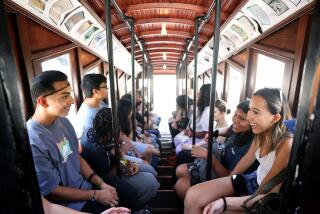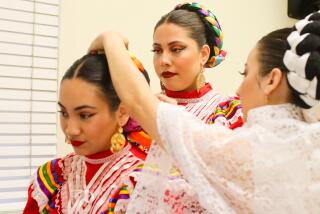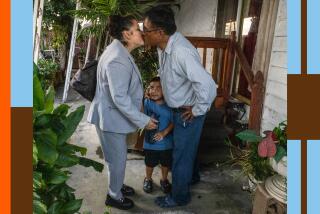Immigration Tales, Without Labels
- Share via
NEWTON, Mass. — When seven high school students from immigrant families answered a museum’s call to help create an exhibition on local immigration, there was a hitch.
The students -- who came from Mexico, South Korea, Russia and China -- didn’t want to use the word “immigration,” not even once.
“Their friends and neighbors hear the word ‘immigration’ and make so many assumptions,” said Sheila Sibley, education manager at the Newton History Museum, just west of Boston. “The word for them came with too much baggage.
“They didn’t want to use it as a noun.”
In fact, nowhere in the museum’s “Hyphenated-Origins: Going Beyond the Labels” exhibition does the “I-word” appear.
The exhibition happens to coincide with a growing national debate on immigration as Congress wrestles with the issue. As senators argue about numbers and national policies, “Hyphenated-Origins” spins seven individual tales of opportunity, heritage, assimilation, fear and change told through the students’ own words, keepsakes, pictures and poems.
“We decided not to do an academic exhibit,” said Susan D. Abele, museum curator and acting director. “We asked them what their life was like. How they got here.”
The museum is housed in a Colonial mansion in the Jackson Homestead, which belonged to a family who first settled across the Charles River from Boston in the 1600s. The Newton History Museum is a certified stop on the Underground Railroad that helped runaway slaves escape to freedom.
“Hyphenated-Origins” documents a more contemporary journey. High school junior Yin Yue Wong, who emigrated with her parents from Hong Kong six years ago, says she will never forget when she first stepped off the plane.
“I thought I had landed on planet Mars until I realized there was a sign saying, ‘Welcome to the United States of America,’ ” she wrote in her display.
That sentiment is shared by others. There is a life-size photographic cutout of each student holding a sign that reads, for example, “Hi, I’m ... Chinese American.” The cutouts can be rotated to reveal bulleted facts about each teen.
Ken Zhao was born in 1989 in Shenyang, China, and moved to Quincy in 1994. His favorite word is “Yes,” because it is “so positive.”
The idea, Abele said, is to go beyond ethnic labels and humanize the world.
Next to each cutout is a collage displaying writings, artifacts and pictures that help illustrate each student’s story.
Beata Shuster, a Russian Jew and a senior at Newton South High School, fled her homeland as a 1-year-old with her parents because of anti-Semitism. Her collage includes a picture of her as a 2-year-old slurping her first American ice cream cone, with vanilla dripping off her chin. The image is juxtaposed with traditional black-and-red Russian napkin holders and other details from the heritage the family had to leave behind.
Andrea Jacqueline Navarro Lujan came from Mexico City at age 4 in 1989. She included a Mexican Barbie doll and a recipe for pork and hominy soup.
A senior at Newton North High School, Lujan, 16, wrote that it was fascinating to grow up in “a strong Hispanic community” in the United States where there is a “real sense of communal struggle.”
She has watched her mother and uncles work through language and assimilation classes and fight forces beyond their control.
“The stereotypes are real and my family and I battle them everyday,” Lujan writes.
The exhibition is open through February 2008.
More to Read
Sign up for The Wild
We’ll help you find the best places to hike, bike and run, as well as the perfect silent spots for meditation and yoga.
You may occasionally receive promotional content from the Los Angeles Times.






